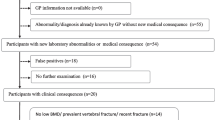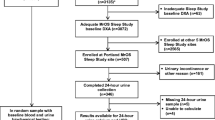Abstract
Summary
Falls and fractures constitute a major cause of morbidity and mortality among older adults. Although falls and fractures share similar risk factors, there is no integrated approach to identifying secondary causes of both entities. We report a cost-effective approach to identify metabolic causes of falls and fractures in the clinical setting.
Purpose
Falls and fractures are a major cause of morbidity and mortality among older adults. Metabolic disorders contributing to the combined risk of falls and fractures are frequent but often go undetected. The most efficient and cost-effective laboratory screening strategy to unmask these disorders remains unknown. The purpose of this study was to identify the most cost-effective laboratory tests to detect undiagnosed metabolic contributors and to decide treatment of these disorders in older persons.
Methods
This is a cross-sectional study design, which included all participants attending the Falls & Fractures Clinic, Nepean Hospital (Penrith, Australia) between 2008 and 2013. Chemistry profile included 25(OH) vitamin D, parathyroid hormone (PTH), albumin, creatinine, calcium, phosphate, vitamin B-12, folate, and thyroid-stimulating hormone (TSH) for all patients, and serum testosterone in men. The number of new diagnoses identified and their cost-effectiveness (cost in US$ per patient screened and cost per new diagnosis) were calculated.
Results
A total of 739 participants (mean age 79, 71 % female) were assessed. Among 233 participants with complete laboratory tests, previously undiagnosed disorders were identified in 148 (63.5 %). Vitamin D deficiency (27 %) and hyperparathyroidism (21.5 %) were the most frequent diagnoses. A testing strategy including serum vitamin D, calcium, PTH, creatinine/estimated glomerular filtration rate (eGFR), and TSH for all patients and serum testosterone in men would have been sufficient to identify secondary causes of falls and fractures in 94 % of patients at an estimated cost of $190.19 per patient screened and $257.64 per diagnosis.
Conclusions
The minimum cost-effective battery for occult metabolic disorders in older adults at risk of falls and fractures should include serum vitamin D, PTH, TSH, creatinine/eGFR, testosterone (in men), and calcium.

Similar content being viewed by others
References
Phelan EA, Mahoney JE, Voit JC, Stevens JA (2015) Assessment and management of fall risk in primary care settings. Med Clin North Am 99:281–293
Deandrea S, Bravi F, Turati F, Lucenteforte E, La Vecchia C, Negri E (2013) Risk factors for falls in older people in nursing homes and hospitals. A systematic review and meta-analysis. Arch Gerontol Geriatr 56:407–415
Kannus P, Sievänen H, Palvanen M, Järvinen T, Parkkari J (2005) Prevention of falls and consequent injuries in elderly people. Lancet 366:1885–1893
Demontiero O, Gunawardene P, Duque G (2014) Postoperative prevention of falls in older adults with fragility fractures. Clin Geriatr Med 30:333–347
Tannenbaum C, Clark J, Schwartzman K, Wallenstein S, Lapinski R, Meier D, Luckey M (2002) Yield of laboratory testing to identify secondary contributors to osteoporosis in otherwise healthy women. J Clin Endocrinol Metab 87:4431–4437
Hudec S, Camacho P (2013) Secondary causes of osteoporosis. Endocr Pract 19:120–128
Bours SP, van Geel TA, Geusens PP, Janssen MJ, Janzing HM, Hoffland GA, Willems PC, van den Bergh JP (2011) Contributors to secondary osteoporosis and metabolic bone diseases in patients presenting with a clinical fracture. J Clin Endocrinol Metab 96:1360–1367
Bours SP, van den Bergh JP, van Geel TA, Geusens PP (2014) Secondary osteoporosis and metabolic bone disease in patients 50 years and older with osteoporosis or with a recent clinical fracture: a clinical perspective. Curr Opin Rheumatol 26:430–439
Huo YR, Suriyaarachchi P, Gomez F, Curcio CL, Boersma D, Muir SW, Montero-Odasso M, Gunawardene P, Demontiero O, Duque G (2015) Phenotype of osteosarcopenia in older individuals with a history of falling. J Am Med Dir Assoc 16:290–295
Ensrud KE, Parimi N, Fink HA, Ishani A, Taylor BC, Steffes M, Cauley JA, Lewis CE, Orwoll ES, Osteoporotic Fractures in Men Study Group (2014) Estimated GFR and risk of hip fracture in older men: comparison of associations using cystatin C and creatinine. Am J Kidney Dis 63:31–39
Garin MC, Arnold AM, Lee JS, Robbins J, Cappola AR (2014) Subclinical thyroid dysfunction and hip fracture and bone mineral density in older adults: the cardiovascular health study. J Clin Endocrinol Metab 99:2657–2664
Svare A, Nilsen TI, Asvold BO, Forsmo S, Schei B, Bjøro T, Langhammer A (2013) Does thyroid function influence fracture risk? Prospective data from the HUNT2 study, Norway. Eur J Endocrinol 169:845–852
Bell JJ, Bauer JD, Capra S, Pulle RC (2014) Concurrent and predictive evaluation of malnutrition diagnostic measures in hip fracture inpatients: a diagnostic accuracy study. Eur J Clin Nutr 68:358–362
Swart KA, van Schoor N, Lips P (2013) Vitamin B12, folic acid, and bone. Curr Osteoporos Rep 11:213–218
Holloway KL, Kotowicz MA, Lane SE, Brennan SL, Pasco JA (2015) FRAX (Aus) and falls risk: association in men and women. Bone 76:1–4
Binkley N, Buehring B (2009) Beyond FRAX: it’s time to consider “sarco-osteopenia”. J Clin Densitom 12:413–416
Järvinen TL, Sievänen H, Khan KM, Heinonen A, Kannus P (2008) Shifting the focus in fracture prevention from osteoporosis to falls. BMJ 336:124–126
Gomez F, Curcio CL, Suriyaarachchi P, Demontiero O, Duque G (2013) Differing approaches to falls and fracture prevention between Australia and Colombia. Clin Interv Aging 8:61–67
Hill KD, Moore KJ, Dorevitch MI, Day LM (2008) Effectiveness of falls clinics: an evaluation of outcomes and client adherence to recommended interventions. J Am Geriatr Soc 56:600–608
Hanley A, Ali MT, Murphy J (2010) Early experience of a fall and fracture prevention clinic at Mayo General Hospital. Ir J Med Sci 179:277–278
Diab DL, Watts NB (2013) Secondary osteoporosis: differential diagnosis and workup. Clin Obstet Gynecol 56:686–693
Gallagher JC, Sai AJ (2010) Vitamin D insufficiency, deficiency, and bone health. J Clin Endocrinol Metab 95:2630–2633
Cameron ID, Gillespie LD, Robertson MC, Murray GR, Hill KD, Cumming RG, Kerse N (2012) Interventions for preventing falls in older people in care facilities and hospitals. Cochrane Database Syst Rev 12, CD005465
Szulc P, Kaufman JM, Orwoll ES (2012) Osteoporosis in men. J Osteoporos 2012:675984
Bogoch ER, Elliot-Gibson V, Wang RY, Josse RG (2012) Secondary causes of osteoporosis in fracture patients. J Orthop Trauma 26:e145–e152
Mitchell PJ, Chem C (2013) Secondary prevention and estimation of fracture risk. Best Pract Res Clin Rheumatol 27:789–803
Huhtaniemi I (2014) Late-onset hypogonadism: current concepts and controversies of pathogenesis, diagnosis and treatment. Asian J Androl 16:192–202
Holick MF, Binkley NC, Bischoff-Ferrari HA, Gordon CM, Hanley DA, Heaney RP, Murad MH, Weaver CM (2011) Endocrine society. Evaluation, treatment, and prevention of vitamin D deficiency: an endocrine society clinical practice guideline. J Clin Endocrinol Metab 96:1911–1930
Pasco JA, Henry MJ, Kotowicz MA, Sanders KM, Seeman E, Pasco JR, Schneider HG, Nicholson GC (2004) Seasonal periodicity of serum vitamin D and parathyroid hormone, bone resorption, and fractures: the Geelong osteoporosis study. J Bone Miner Res 19:752–758
Tajar A, Lee DM, Pye SR, O’Connell MD, Ravindrarajah R, Gielen E, Boonen S, Vanderschueren D, Pendleton N, Finn JD, Bartfai G, Casanueva FF, Forti G, Giwercman A, Han TS, Huhtaniemi IT, Kula K, Lean ME, Punab M, Wu FC, O’Neill TW (2013) The association of frailty with serum 25-hydroxyvitamin D and parathyroid hormone levels in older European men. Age Ageing 42:352–359
de Souza Genaro P, de Medeiros Pinheiro M, Szejnfeld VL, Martini LA (2015) Secondary hyperparathyroidism and its relationship with sarcopenia in elderly women. Arch Gerontol Geriatr 60:349–353
Fliser D (2008) Assessment of renal function in elderly patients. Curr Opin Nephrol Hypertens 17:604–608
Glassock RJ, Winearls C (2008) Screening for CKD with eGFR: doubts and dangers. Clin J Am Soc Nephrol 3:1563–1568
Hemmelgarn BR, Zhang J, Manns BJ, Tonelli M, Larsen E, Ghali WA, Southern DA, McLaughlin K, Mortis G, Culleton BF (2006) Progression of kidney dysfunction in the community-dwelling elderly. Kidney Int 69:2155–2161
Acknowledgments
This study was supported by a grant from the Nepean Medical Research Foundation. The authors would like to thank the Nepean Blue Mountains Local Health District for their support to the Nepean Hospital Falls and Fractures Clinic.
Conflict of interest
None.
Author information
Authors and Affiliations
Corresponding author
Rights and permissions
About this article
Cite this article
Johnson, K., Suriyaarachchi, P., Kakkat, M. et al. Yield and cost-effectiveness of laboratory testing to identify metabolic contributors to falls and fractures in older persons. Arch Osteoporos 10, 21 (2015). https://doi.org/10.1007/s11657-015-0226-3
Received:
Accepted:
Published:
DOI: https://doi.org/10.1007/s11657-015-0226-3




